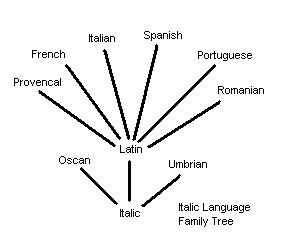

The Romance languages, French, Spanish, Portuguese, Romanian and, of course, Italian, all clearly grew from Latin. Oscan and Umbrian, which are also members of the Italic branch of the Indo-European language family tree, were supplanted by Latin around the first or second century C.E. The early languages of Italy, such as Umbrian, have been particularly well-studied. For example, there is extensive text of Umbrian inscribed in the bronze Tablets of Gubbio. These hark back to a proposed general Italic language, which derived from one of the branches of the Indo-European language family tree.
To make things really confusing, certain Italic tribes, such as the Oscans, Umbrians, Sardinians, etc., banded together against Rome coalition called Italia. But the people of Italia were not speaking the original Italic language.
Etruscan is not on this tree. Although Etruscan is an ancient language of central and northern Italy, and flourished there as an early contemporary of Latin, it is not part of Indo-European family of languages.
Yet, the Etruscan culture strongly influenced the Roman culture. For example, the toga, that garment many people associate with the Romans, was actually Etruscan in origin. The Roman arch, subscribed to being an invention of the Romans, is actually a feature of the Etruscan civilization. Even more interestingly, Romans treated the Etruscan language in a manner similar to how the later Europeans treated Latin. When the Etruscan language was dying out, the Romans still preserved it as a langage of scholarship and, in particular, as a liturgical language for certain rites.